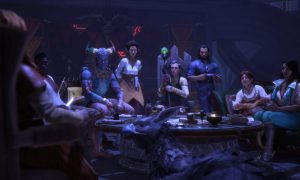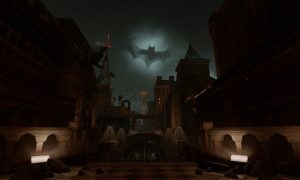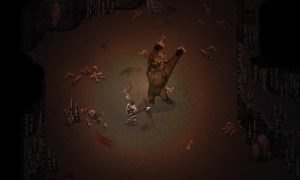I wasn’t prepared.
I’ve watched every Twitch video, I went through the E3 demo twice, and I’ve consumed every character of written word about Dragon Age Inquisition. I still wasn’t ready for what came next.
Like a kid on Christmas morning, I couldn’t sleep the night before. I’m not sure if it was the road construction that persisted throughout the entire night, finishing up at around 6am when my alarm went off, or the years of waiting for another episode in what has become one of my favorite worlds that Bioware has ever created, but I was wide eyed and awake.
With little more than a “Hope you enjoy what we’ve created” and some housekeeping advising us to avoid spoilers (like I’d do that to you!), we were given carte blanche to drive as much content into our eyeballs over the next six hours as we could physically muster. I did a lot of cramming.
The preview I write below will contain minor spoilers, as will the video above, but I’ve done my best to remove any major spoilers, even muting conversations that might give you a hint on the storyline that awaits you not long after you read this. If I’ve missed any, know that you’ll see everything I saw within your first ten or so hours of play. I say ten as, when I looked around at where others had taken their adventure, I didn’t recognize many of their locales. Your adventure is what you make of it, and it takes place where you drive it – it’s your world, imperiled as it is.
It’s likely you already know at least the broad strokes of the setup for Dragon Age Inquisition. After a massive explosion rips The Fade asunder, killing everyone in a large radius around the event, you are found unconscious but alive at the epicenter. Skipping ahead, let’s just say that the locals are well aware of who you are, and that you are part and parcel to the deaths of hundreds if not thousands of their loved ones. Long before you will become Inquisitor, you will be a pariah.
The first companion to join you is Cassandra Pentaghast, Seeker of the Chantry. If you played Dragon Age II, you know full well that she has little regard for anything but the truth. When she ties the eerie glow of your hand to the tear in the sky, you can imagine she has some ‘pointed’ questions for you. Realizing that you are the only hope she has for closing the rifts that are rapidly destroying Thedas, she joins with you rather than clapping you in irons as The Chantry demands. Joined by series mainstay Leliana, Varric, and his lady love Bianca, as well as a whole host of new faces, it is now up to this band of unlikely heroes to prevent the mysterious tear in The Fade from destroying everything they know. That is, if the war between the Mages and the Templars doesn’t destroy it first.
The best of both worlds in an open world
The first thing you’ll see, or more accurately won’t see, is that the minimap in Dragon Age Inquisition no longer reflects the tight corridors and narrow pathways of its predecessor. Our demo wasn’t limited in any way, but I’ll be focusing on The Hinterlands for this preview. This area has been shown quite a bit in demonstration videos, but given that the scope of this single area is still larger than the entirety of Dragon Age Origins and Dragon Age II combined, even with six hours of play time I didn’t come anywhere close to exploring the whole thing. If I had to venture a guess, I’m going to imagine that I saw maybe 10% of it.
After the prologue I was given some brief tutorials on the new mechanics of Inquisition, most notable being the tactical combat system. A blend between Origins and II, the system allows for both tactical and real-time play styles. Playing on the Xbox One, I pressed the View button (that’s the one with the two boxes on it) which immediately paused combat. From there I could use the left and right thumbsticks to move around the battlefield, swinging the camera around to assess the threats therein. On the PC, this is accomplished with the mouse and keyboard, making selection more fluid, but after a few battles with the console mechanics I found it to be fairly natural. Using the D-Pad to select between my four party members and the face buttons, bumpers, and triggers to select my various powers and skills, I was able to plan out my attack utilizing each party member’s strengths and powers to their highest potential.
The tactical camera opened up potential for better attack planning. As I swung the camera over the landscape I noticed an archer just outside of the field of view. With this tactical camera I was able to anticipate his ranged attacks and react accordingly. As mages and demons joined the fray, having a ranged defense became more important. It was when the Templar Knights with shields showed up that the tactical system really showed its power.
Using the real-time combat system, you are relying on the AI to position properly to take out these shielded behemoths. Since they, like Cassandra, are all but impervious to a frontal assault, flanking becomes critical. Certainly, you are welcome to take control of a companion and move them into the proper position, and the AI does a great job of managing that for the most part, but the tactical camera is certainly superior. Pausing the action I placed Cassandra in front of the Templar Knight, issuing an order for her to attempt to hold his attention. With the Templar Knight distracted, I told Varic to vanish and moved him to a flanking position. Solas lobbed fire from afar while my Inquisitor moved to the rear and launched continuous attacks. This coordinated assault made light work of the otherwise indestructible foe. In the end I found that I didn’t subscribe to either system exclusively, using either or both combined based on the needs of the situation.
I uncovered something I didn’t expect with the new engine – natural chokeholds. We’ve seen demonstrations where warriors are able to hold a gap to keep softer targets behind them safe, but during one sequence I was able to use the tactical system to drive an enemy backwards into a small tree grove. With his back to the foliage and no way to escape, I was able to pin him into this spot, holding him in place with a Shield Wall power and ripping him apart with my casters. It was unexpected, but also served as a healthy warning – I don’t want this happening to me. Position matters more than ever.
Bioware storytelling
There are companies that tell compelling stories, but few that do it as well or as uniquely as Bioware. Every character feels like a complete person, not a generic companion better identified by their class than their personality. While I only got to interact with a few of the many team members that will join the Inquisition during my brief time with the game, it seems that Bioware has once again built a world full of compelling souls. Given that they can no longer rely on the closed off hallways and tightly triggered corridors, somehow they’ve built a story that still works in an open and free-flowing world.
The conversation system has received a bit of an overhaul for Dragon Age Inquisition. Gone are the obvious good, neutral, and bad options, instead replaced by more of a general ‘feeling’ than the exact verbiage of your response. The team has also used this opportunity to inject more opportunities for special outcomes based on race, class, companion in the party, and more. Maybe Varric knows a guy who knows a guy, maybe Solus has hidden knowledge of a nearby rune — anything is possible. During one interaction I had busted a smuggler and was given the option of asking Cassandra or Varric their opinion on the subject, yielding a more steadfast and just response, or a more pragmatic and possibly profitable response.
Another aspect of the game that has been adjusted was the loyalty meter in Dragon Age II. As people were essentially ‘gaming’ the system, that loyalty engine is now hidden. This results in a more natural response rather than purposefully shaping the outcome to fit a particular end. There are still flags that pop up stating that a companion feels one way or another on a topic (which, of course, can be toggled off or on in the options), but you will no longer have a visible indicator of affection or loyalty.
I can’t say more on the story beyond the mechanics without revealing storyline that would be better experienced firsthand. Suffice it to say that the team at Bioware has taken their writing to a whole new level, and fans of their storytelling style will not be disappointed.
Frostbacks in Frostbite
I believe one of the major reasons the team was able to focus so hard on storytelling was their decision to use EA’s Frostbite 3 Engine — the same engine that will power most of EA’s upcoming shooter properties. By overcoming some technical challenges, (the engine not supporting bipedal creatures like horses or dragons, as an example) the team was able to hit the ground running with an engine capable of bringing a heavily-populated world to life. Grass that flows in the wind, character models that are drastically improved for current-gen platforms, the ability to pause (which granted the game its tactical system), improved animations and visual fidelity, and a fantastic lighting engine just scratches the surface of what this incredible engine can bring to the table. Its mature feature set let the team focus on what they do best — create compelling RPGs.
I saw one instance where the engine showcased its destruction capabilities, but in reverse. It’s unclear this early in the game why you have this power, but I found a building structure that had collapsed. Using the fade power in my hand, I was able to reconstruct the broken blocks to their usable state, allowing me to pass. Again, I don’t want to spoil the context, but it’s something we’ve only seen briefly.
The Frostbite 3 Engine brings this entire world to life. There are a few lower resolution textures here and there on the Xbox One version I played, but overall it is absolutely staggering just how much the team has packed into the game. Armor looks pretty fantastic up close, as do all of the faces and creatures. The ground is alive with animals, grass, trees, flowers, and so much more. We’ll skip the resolution nonsense, but I am happy to say that no matter how much chaos was unfolding on the screen, the framerate never dropped.
The other thing I want to point out is a promise we hear so often and very rarely see realized — “if you can see it, you can go there”. In Dragon Age Inquisition, in the six hours I played, I found this to be entirely true. Standing on a hill I was able to see no less than 50 trees, some shrubs, a mountain range covered with foliage, a well, a fence, a small encampment, a few rams and fennec foxes, rocks, and much more. These things aren’t just sitting static in the background either — everything is in motion. It was surprising to see just how alive the world of Thedas has become in this new engine.
We aren’t prepared for war
With a war tearing itself apart, and two dangerous factions in open conflict, the Inquisition is unprepared to stand strong against either. A big part of preparing your crew for war, other than recruiting companions, is war requisitions and reclaiming Thedas from both factions. Reclaiming camps in the land helps spread your Inquisition’s influence, but it uncovers other needs. Your Inquisition Requisition Officers, Blacksmiths, and others will request specific things to help strengthen your forces for the inevitable war you’ll unleash. This can be as simple as collecting iron ore from the mountains, but might require digging through exotic locations or collecting unique items. It’ll be interesting to see how that comes together, but the most immediate net result was crafting.
In the two previous games the most powerful weapons were unique, either found or often purchased. As the game world opened up, now you are able to collect a vast array of resources to craft and upgrade your own weapons and armor. I had collected some materials such as leather, cloth, and drakeskin, allowing me to craft a new Apprentice Coat. Discovering new schematics and gathering the necessary materials to make more powerful weapons and armor didn’t just apply to my character and companion, though – you’ll need to outfit your soldiers as well. My first requisition was for tents to keep warm and better swords to arm themselves, but it is clear that this mechanic runs deep and throughout the entire game’s arch.
A fitting and painful end
One of the primary objectives in the game is to utilize your newfound power to close the rifts located around the world. Approaching any of them causes demons to spew from the shards of crystal floating in the sky. After killing multiple waves of enemies I was able to approach the shard and close it. There are many more, so I set off to find them.
I stumbled across something that I don’t think has been shown in any of the video demonstrations for the game — Astrariums. I found an ornate globe on top of a stone and obsidian pedestal. With no context I did the only thing I could possibly do — I walked up to it and poked at it! It immediately sprang to life, swirling with blue magic. Taking me to a new screen, it gave me a view of the sky. In the right corner was a simple six star constellation and challenged me to recreate the image by connecting the stars without making the same line twice. Completing the puzzle revealed that there were two more in the Hinterlands to discover, as well as a brief story about the constellation I had uncovered – Judex. How these puzzles tie in is still a mystery, but I can’t wait to discover and solve them all.
As I explored, I uncovered a place called Lady Shayna’s Valley. It rang an immediate bell, and Varric quickly confirmed my greatest fears. “Up she goes”, he remarked as a massive dragon swung wide around a nearby bluff where she was perched, clipping the edge with her wing. Everything after this moment was fire and pain. With a single fireball hurtling at my party, all I could do was stand in horror and watch. The impact was devastating, killing three of my party members instantly, their brief screams and frantic attempts to escape the immolation entirely in vain. I thought the dragons in both previous games were rather easy to take down — the dragons in Dragon Age Inquisition are not to be trifled with and will quickly punish you for invading their space.
If the first six hours of Dragon Age Inquisition are any indicator of the 141 hours of remaining content (50 of which comprises the main storyline), we are all in for a huge treat. The open world changes everything about this game, and somehow the team at Bioware have managed to bring the same incredible storytelling to that wide-open space. Combine it with the best parts of combat in both previous games, and you have a recipe for the sort of RPG that sets the tone for an entire new generation of storytelling.
Dragon Age Inquisition is heading to Xbox 360, PlayStation 3, Xbox One, PlayStation 4, and PC on November 18th. It’s the game they’ve always wanted to make and trust me, you aren’t prepared.
Ron Burke is the Editor in Chief for Gaming Trend. Currently living in Fort Worth, Texas, Ron is an old-school gamer who enjoys CRPGs, action/adventure, platformers, music games, and has recently gotten into tabletop gaming.
Ron is also a fourth degree black belt, with a Master's rank in Matsumura Seito Shōrin-ryū, Moo Duk Kwan Tang Soo Do, Universal Tang Soo Do Alliance, and International Tang Soo Do Federation. He also holds ranks in several other styles in his search to be a well-rounded fighter.
Ron has been married to Gaming Trend Editor, Laura Burke, for 28 years. They have three dogs - Pazuzu (Irish Terrier), Atë, and Calliope (both Australian Kelpie/Pit Bull mixes), and an Axolotl named Dagon!

See below for our list of partners and affiliates:

































